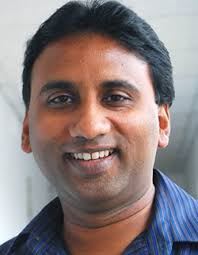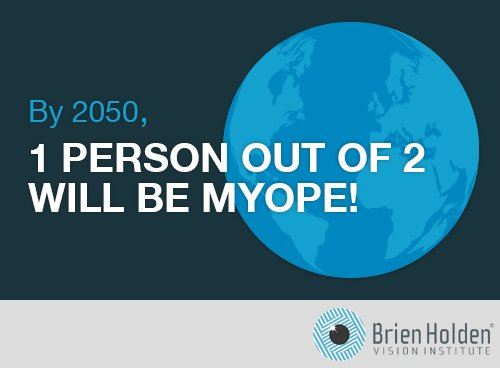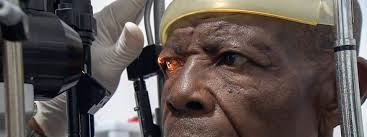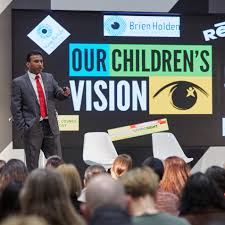Interview with Professor Kovin Naidoo, CEO of the Brien Holden Vision Institute
by Kevin Shaw

Last week I was fortunate enough to catch up with Professor Kovin Naidoo over Skype. Below is an invaluable insight for Young Optometrists looking to get more involved in the public health sector. His story epitomises a life dedicated to giving vision to everyone, everywhere.
Richard: Thank you for taking the time to have a chat. Firstly, you are obviously very passionate about eye care. Have you ever wanted to get involved in other aspects of public health? For example clean water projects, vaccine programs etc.
Kovin: Given my roots in South Africa I think I would have been involved in the HIV/AIDs campaign. It has devastated a large portion of our population. When I was choosing between Optometry and general medicine, if I chose medicine I would have got involved in HIV/ AIDs.
R: How much do you currently travel as CEO of Brien Holden Vision Institute (BHVI)? Where are you based?
K: I am now based in Sydney. Our other major office is in Durban, South Africa so I do go back and forth. The job involves a lot of travel as the BHVIhas worked in 54 countries.
R: You currently serve on the board of many organisations, how much overlap is there between being on the board of the World Council of Optometry, Vision 2020 and International Agency for the Prevention of Blindness (IAPB) for example? To what extent do they work together?
K: The good thing about the eyecare space is that it is a fairly defined community, there is a great deal of overlap, you meet different organisations in different forums etc. The bad thing about it is that it is mainly eyecare people and increasingly the main discussion is how do we create campaigns and efforts that interface with the broader community and civil society. Whether it is organisations involved in child rights or labour issues or organisations worried about road safety because at the end of the day vision is not a narrow health issue, it has other socio economic implications whether it is education for children or work for adults. So it makes sense for us to really go outside that box.
R: Over the years have you seen a change in the dynamics between Ophthalmology and Optometry in the public health space?
K: I think the positive thing in the public health space is that Optometry and Ophthalmology are working very closely together. When I was elected chair of the IAPB in South Africa, the majority of IAPB members were from Ophthalmology. Since we worked so closely together the issue was not what profession you were from it was about what you can bring to the table for our collective purpose. All my co-chairs except one were ophthalmologists. As a result of that cooperation, almost all of the schools of optometry that the BHVI helped set up were supported by local ophthalmologists. I think it’s a good thing. I think in the private sector there is always a contestation and an issue in terms of relations but in the public sector we have worked together very successfully.
R: You have a Masters in Public Health and a PhD from UNSW, are these necessary for Optometrists who want to work in the public health sector?
K: I think it is very important to have a broader understanding. I did my Masters in Public Health in the USA. It was very much around understanding epidemiology, program planning and evaluation, health promotion and within that it was about how you advocate for better health and health systems management. These are skills that help you to define strategy within eyecare. For example, increasingly we have come to realise we cannot solely be providing service delivery; we need to look at health promotion. If you look at the myopia crisis that the world is facing, in developed countries such as Australia, the solution is not us as non-government organisations going and providing services, people already have easy access to Optometric services but there is a huge importance for health promotion campaigns to get parents more sensitive to the fact that myopia progression is a major public health issue of our time and that they need to do something about it. I think a Public Health degree allows you to see health in a more holistic way.
The PhD is usually something that allows you to focus more on your core influence of study. So I did my PhD on epidemiological studies within that space because I wanted to learn more and take that skill to another level.

R: Did you yourself think a PhD was a good idea or did someone like Professor Brien Holden encourage you to do it?
K: Actually at that time I did not want to do a PhD because BHVI was growing so fast, we were on the road perpetually; the challenges on us were enormous. The university system demands a PhD of you. If you do not have a PhD you cannot lecture and supervise students and we were recruiting a lot of students to do socially relevant research and I needed to supervise. The masters gave me a lot of skills. If I had a choice at that time I would not have done it. I think doing a PhD forces you to subspecialise, it allowed me to stop and focus on what I am interested in, to go deeper and that has become my research focus now.
R: What can Australian Optometrists in private practice do to support sustainable optometry in other countries? Maybe get involved in teaching at universities? What would be a good first step in the public health sector?

K: Volunteering for a sustainable effort is good. If you want to go overseas, make sure you link up with the local optometry school, impart your knowledge and help the students. Make sure that there is some sustainable outcome from your trip. Just going and providing eyecare services for a small number of people and leaving is not the most ideal thing. Getting involved with projects that talk about sustainability and empower the people in those countries to make a difference is a great thing to do.
If I was a young Australian optometrist, I think we are at a junction in our history as a profession where we should be asking what should we be doing in Australia first because if you look at the myopia epidemic we have a major crisis looming in the world and I think there is an opportunity for young Optometrists to ask what can we do to become knowledgeable about myopia control. It is more than just about being a private practice income generator.What can we do to create greater awareness of myopia control? To invest in school programs to educate kids and parents? What can we do to influence public policy to increase children’s time spent outdoors?Of course if you are interested in working in poorer communities in Australia or globally you can take that forward as well.
R: What about getting involved in BHVI?
K: There are many different things that Optometrists do interfacing with us. Firstly there is postgraduate work such as PhD etc. Some work in public health programs, implementing programs either clinically or managing programs. Then we have research Optometrists in our clinics that see patients as part of our myopia research or our presbyopia research or our ocular comfort research etc. So those are the various levels of interaction. And now we are also interested in developing entrepreneurship models that can increase access to eyecare. So some optometrists we have working with us have a good business sense and they combine that with a public health sense to be able to support entrepreneurship for development.
R: Is funding the main thing holding back optometry in developing countries? What about the Haiti Optometry School project, how was that funded?
K: Funding is a major issue. The Haiti project is a culmination of various schools of optometry that we have set up in different parts of the world, the first one we did was in Malawi followed closely by Mozambique and it costs us in excess of 3 million dollars to do each one. The problem is that funders do not find that sexy. Funders like projects where you do an eye camp and you take nice pictures where the children are smiling etc. The reality is that we at BHVI decided to do this because it is the right thing to do. What it has done is create a generation of optometrist in Malawi, Mozambique, Kenya, and Mali as well as in Vietnam. It is creating generations of optometrists who would be able to serve their people on their own and would be able to make our services obsolete.
This is the true approach to development. Development is not about dependency; it is about creating independence for those you interact with. They get the skills and resources to do it on their own. We see the BHVI as a catalytic organisation rather than an organisation that wants to entrench itself in these projects. Governments are very keen, as I told you through the IAPB collaborations we are getting a lot of support from Ophthalmology for this but the issue is that we need more funding. That’s why in Haiti it was important to bring a coalition of organisations together and hopefully with Optometry Giving Sight we can get the kind of money we need for that.
R: I am very happy to hear that countries which have never had optometric coverage before are finally getting it.
K: Unfortunately it is the reality for many African countries even LatinAmericancountries; you have millions of people who do not have access to an optometrist.
R: Which countries currently stand out as having the poorest access to eyecare?
K: Haiti is one of the poorest countries in the world. We do a lot of work in PNG as well. We have a presence in India as well as many Africancountries, which is where I would say the biggest need is. We also have an office in Bogotá, Columbia because there are some Latin American countries that don't have access to Optometrists so we provide assistance to them in different ways.
 R: What does the next 10 years look like for the BHVI?
R: What does the next 10 years look like for the BHVI?
K: One of the things we have done is we have focused our efforts around a key strategic priority and that key strategic priority is myopia. We see ourselves expanding our research in the myopia space both in spectacle lenses and contact lenses. We have launched a global campaign called Our Children's Vision where we hope to reach 50 million children by the year 2020. We have 70 plus organisations who have joined that coalition including non-eye care organisations like Save the Children etc. So we want to expand that collaboration and opportunity. Through those efforts we can expand the impact that we can make.
We have come to the realisation we need to be more focused and you may have seen the paper that we published where we found 50% of the world’s population will be myopic by 2050 and 20% of those will be greater than -5.00DS which comes with it increased risk of glaucoma, cataracts etc. So we think the world is on the cusp of one of the biggest public health challenges of our time and its unique compared to all the campaigns for malaria, trachoma etc. because it affects both the developed and developing world so this is a truly global crisis we are facing. Lifestyle changes are happening all over the world so we see ourselves focusing on that with our research as well as education through our myopia education programs.
R: Thank you for your time Professor Naidoo.
Links you may be interested in:
Brien Holden Vision Institute: https://brienholdenvision.org/
World Council of Optometry: http://worldcouncilofoptometry.info/
International Agency for the Prevention of Blindness: https://www.iapb.org/
Vision 2020 Australia: http://www.vision2020australia.org.au/
Our Children’s Vision campaign: http://www.ourchildrensvision.org/